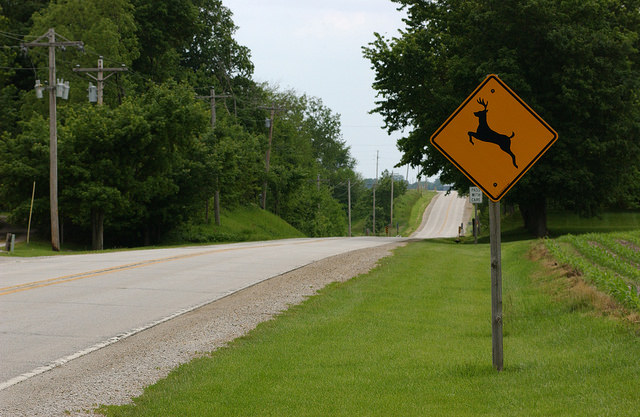Blog
7 Tips for Safe Driving During “Deer Season”

Although the first of October is the official start of deer hunting season, it is not the only deer season that starts. What I am referring to is the first part of October also brings the season of more automobile/deer collisions. According to the Insurance Information Institute, 1.6 million vehicle/deer collisions occur each year, resulting in 200 fatalities, tens of thousands of injuries and over $3.6 billion in vehicle damage. Even though auto/deer collisions happen all year long, it happens more during this time of year. This time of year has deer moving for many different reasons. When deer move around more, there are more chances for these types of collisions. Some of the reasons that deer move more at this time of year are:
1. More crops are being harvested. This time of year the animals sometimes have to travel farther for food sources.
2. There is less cover. When crops are harvested, there is less cover for them to hide and loaf in. Deer travel to find a place they feel safe in and no predators can see them.
3. The days are shorter. This coincides with the movement of deer. They travel more at dawn and dusk.
4. Our paths can cross. The deer movement at dawn and dusk also coincides with our going to work or school around the same time. We go to work around the time the sun rises and we go home from work around the time the sun sets. The chances of these types of collisions are greater because we are both moving around the same times.
5. Hunting season starts. Hunters can cause deer to move around to places they normally do not go. They feel the need to escape the hunting pressure.
6. Mating season. One of the biggest reasons though, is mating season will begin soon. Deer generally mate towards the end of October through the month of November. This is when we see the most auto/deer collisions. The male deer are searching for a mate and pay little if any attention to their surroundings. They are looking for one thing, females. They will travel as far as they have to to find these females.
Now that we have pointed out some of the reasons that there are more deer collisions at this time of year, lets see if we can give you some advice on how to limit your chances of this unfortunate type of accident happening to you.
1. Limit your travels as much as you can during the dawn and dusk times. These times with the lower light levels can decrease your vision and reaction times. We may have to travel to work and school, but if you can avoid these times, do so.
2. Drive with your headlamps on high beam. As we just stated, the low light conditions make it hard to see them. Increased lighting will help you see better and at greater distances, however be safe and courteous and dim for oncoming traffic.
3. Pay attention to deer crossing signs. Most states post deer crossing signs in areas that historically have a higher instance of auto/deer collisions. When you see these signs, SLOW DOWN.
4. Watch out for the rest of them! Deer are generally herd animals and travel in packs. They rarely travel alone. If you see one cross the road in front of you, watch for their buddy’s.
5. Travel in the center lane. When the road is four lane and when the traffic permits, traveling in the center lane gives you an additional split second to react.
6. Stay on track. If you see a deer, brake firmly and calmly, and stay in your lane. Swerving could make you lose control of your vehicle and turn a bad situation into something much, much worse. Deer are unpredictable and you could swerve directly into their changed path.
7. WEAR YOUR SEATBELT!!! Out of all of this advice, this is the biggest one that could save your life.
So we need to be hyper vigilant looking for deer, especially at this time of year. If the unfortunate happens, here are some things to keep in mind.
1. Pull off to the side of the road as soon as it is safe.
2. Turn your hazard lights on.
3. Call authorities and notify them if anyone is injured or you have damage to your vehicle.
4. Do not approach the animal. You could be injured if the animal is wounded. Wounded animals are VERY dangerous. Let the authorities know if the animal is still in the roadway, making for a dangerous situation for other drivers.
5. Contact your insurance company and start your claims process.
Although this is a small list of tips, we hope that you keep in mind that “deer season” is starting. Auto Works Collision Center wants to keep our customers and their families safe. Please share with friends and family.
